Sometimes great dishes are named after the chefs who create them, like Caesar Salad, or the place where they are served, like Waldorf salad, but often they are named for people that the chef wants to impress or who impress the chef. Desserts are often named after women because sugar-and-spice and all that sexist stuff, but who can object to these sweet treats?
Peach Melba:
The great chef Escoffier created this dessert for his friend Nellie Melba, the Australian opera singer. Nellie loved ice cream but feared that the frozen dessert would damage her vocal cords. Escoffier added peaches to insulate the effect so that Dame Melba could eat ice cream without fear. The first Peach Melba was served in a huge block of ice carved in the shape of a swan to commemorate Dame Melba’s performance in Wagner’s Lohengrin. The raspberry sauce was added in version 2.o.

Nellie seems to have been quite a hypochondriac. At one point, when she was feeling sickly and off her feed, Escoffier invented a dry sweet bread for her called, yes, Melba Toast.
Peach Melba recipe from Nigella.
Pavlova:
Ballerina Anna Pavlova toured New Zealand in 1926 and Australia a few years after. Ever since, the two nations have been fighting over who invented the dessert named after her. The earliest known recipe to be called Pavlova is from a 1927 New Zealand cookbook and is a cake-based trifle rather than a meringue-based cake. In 1934 Australian chef Bert Sachse came up with his version that he adapted from a New Zealand recipe published in 1929. Seems clear to me that some unnamed New Zealand chef (or anonymous housewife) came up with this beauty. Is it still Australian if it’s made with kiwi fruit?

Authentic recipes call for tempering the egg whites with vinegar and adding cornstarch for structure. New Zealanders can buy ready-made Pavlova shells.
Pavlova recipe.
Poires Belle Hélène:
Another dish created by Escoffier, this time to honor the 1864 Offenbach opera, La Belle Hélène and of course its star, Hortense Schneider, alias La Snédèr, whose prima donna attitude almost sank the performance. Maybe if she’d been easier to get along with this dessert would be called Poires Belle Hortense.
The original recipe calls for a candied violet garnish. These are usually replaced by almonds in modern cookery but one cook who tracked down the candy flowers notes:
But: pears poached in syrup, vanilla ice cream, chocolate sauce — flowers if you’ve got ‘em but if not, who can complain?
Recipe.
Crêpes Suzette:
There are two stories behind this dessert. One is that young assistant waiter Henri Charpentier was making a dessert for the Prince of Wales in 1895 when he accidentally caught a pan of liqueurs on fire. Thinking quickly, he dunked crepes in the sweet sauce and served them up. The Prince asked for the name of the dish and Charpentier replied : Crêpe Princesse, after the prince. But future King Edward demurred and requested that the dessert be named after a girl, Suzette, at the table.
Balderdash! says the Larousse Gastronimique. Charpentier was just creating a legend around himself. The flaming flapjacks were actually named after actress Suzanne Reichenberg, stage-name Suzette. In 1897, Suzette was playing a maid who serves a dish of crepes on stage. The crepes were supplied by M. Joseph of the Restaurant Marivaux. He set them aflame so that they would attract attention on stage and still be warm when the actors got around to eating them.
Those are both good stories. Perhaps it matters which is true, perhaps not. Sweet pancakes soaked in booze: what’s not to like?
Recipe.
Victoria Sponge:
Queen Victoria was fond of cake with her tea and this was one of her favorites. Essentially, it’s two sponge cake layers with jam in between so it is sometimes called a Victoria Sandwich. Some add whipped cream and/or berries to the sandwich. The cake is said to have been invented by Anna, Duchess of Bedford, but really, how much of an invention is it to spread jam on cake?
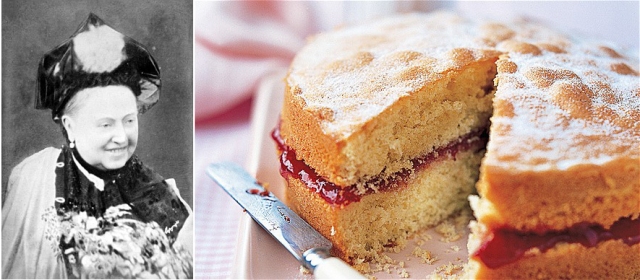
The basic Victoria Cake batter poured over apples and baked is Eve’s Cake, another dessert named after a famous woman (no picture of her provided because the ones I found always left something to be desired).
Recipe from Mary Berry.
Queen Elizabeth Cake:
Well, if Vicky had a cake, how about Liz? Yes, there is a Queen Elizabeth cake — it contains dates and is very moist. There is an old recipe that claims:
Recipe and photo of the printed myth.
Charlotte:
Some silly folk say this is not named after anyone but some kind of deconstruction of an English word — carlet (snerk!)– that was a savory, not a sweet. See how silly that sounds when it’s all laid out for you by an independent observer? But there is more than one kind of Charlotte. There is the fruit (usually apple) Charlotte with a crust of toasted buttered brioche and there is the pudding-type enclosed in lady-fingers.
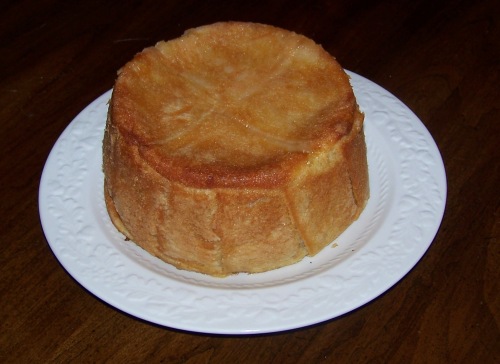
The number one recipe for Apple Charlotte is from Julia Child and many people have imitated it.
But there are other Charlottes, especially Charlotte Russe, which is a bavarian cream encased in ladyfingers. This dish was invented by the great chef Carême for Czar Alexander I, hence the Russe part of the name. But the generic term is for a dessert named in honor of George III’s queen and is some kind of custard or gelatinized cream with a crust of ladyfingers or Savoyard biscuits.
The gelatin in the bavarian cream makes this a very stand-up dish but also one that is going out of fashion. Gelatin (except in commercial preparations like Jell-O) is a vanishing food product. You read it here first.
Recipes for a variety of Charlottes.
Madeleines:
Thanks to Proust, these little cakes are famous. Most everyone agrees that they are named after the cook who created them — one Madeleine Paulmier — but there is some confusion as to when this occurred and the dates differ by a century. Anyway, whenever it was — let’s say 1755 – the Marquise Parrotin de Baumont had a Polish grandee over for dinner at his place in Commercy and Madeleine served these cakes which were a smash hit.
Bakers in Commercy started turning out the creations, factories sprang up, and travellers were besieged at the Commercy railroad depot by vendors with basketloads of cakes, every single one authentic.
Imitation is flattery, Mme. Paulmier, and you are much admired.
Recipe.
Apple Brown Betty:
If you layered apples with bread cubes rather than encasing them in toast, you’d have an Apple Brown Betty rather than an Apple Charlotte. Same ingredients, usually, but a more rustic preparation. Do not be confused: this is not apple crisp! That’s a different dessert. [If you want to learn the difference between crisps, bettys, dowdys, slumps, grunts, buckles, and cobblers, see here.]
The earliest mention of Apple Brown Betty is in a Yale magazine of 1864 and there is little doubt that “Brown” was Betty’s color. Some places have decided that it is best to remove the brown from the dish’s origin and have re-named it Apple Betty. That’s a really dumb idea. You do not eliminate racism by censoring mentions of race but you do eradicate evidence of cultural contributions made by different kinds of folk.
The only thing we know about Betty is her first name and that she was brown. That’s a little more than is known about the millions of other cooks who have labored over the centuries to create art and it helps to make her stand out from the anonymous crowd. Betty, with every spoonful we salute you!
Recipe.
http://shrineodreams.wordpress.com/2012/06/15/famous-lady-desserts/
Peach Melba:
The great chef Escoffier created this dessert for his friend Nellie Melba, the Australian opera singer. Nellie loved ice cream but feared that the frozen dessert would damage her vocal cords. Escoffier added peaches to insulate the effect so that Dame Melba could eat ice cream without fear. The first Peach Melba was served in a huge block of ice carved in the shape of a swan to commemorate Dame Melba’s performance in Wagner’s Lohengrin. The raspberry sauce was added in version 2.o.

Nellie seems to have been quite a hypochondriac. At one point, when she was feeling sickly and off her feed, Escoffier invented a dry sweet bread for her called, yes, Melba Toast.
Peach Melba recipe from Nigella.
Pavlova:
Ballerina Anna Pavlova toured New Zealand in 1926 and Australia a few years after. Ever since, the two nations have been fighting over who invented the dessert named after her. The earliest known recipe to be called Pavlova is from a 1927 New Zealand cookbook and is a cake-based trifle rather than a meringue-based cake. In 1934 Australian chef Bert Sachse came up with his version that he adapted from a New Zealand recipe published in 1929. Seems clear to me that some unnamed New Zealand chef (or anonymous housewife) came up with this beauty. Is it still Australian if it’s made with kiwi fruit?

Authentic recipes call for tempering the egg whites with vinegar and adding cornstarch for structure. New Zealanders can buy ready-made Pavlova shells.
Pavlova recipe.
Poires Belle Hélène:
Another dish created by Escoffier, this time to honor the 1864 Offenbach opera, La Belle Hélène and of course its star, Hortense Schneider, alias La Snédèr, whose prima donna attitude almost sank the performance. Maybe if she’d been easier to get along with this dessert would be called Poires Belle Hortense.
The original recipe calls for a candied violet garnish. These are usually replaced by almonds in modern cookery but one cook who tracked down the candy flowers notes:
But: pears poached in syrup, vanilla ice cream, chocolate sauce — flowers if you’ve got ‘em but if not, who can complain?
Recipe.
Crêpes Suzette:
There are two stories behind this dessert. One is that young assistant waiter Henri Charpentier was making a dessert for the Prince of Wales in 1895 when he accidentally caught a pan of liqueurs on fire. Thinking quickly, he dunked crepes in the sweet sauce and served them up. The Prince asked for the name of the dish and Charpentier replied : Crêpe Princesse, after the prince. But future King Edward demurred and requested that the dessert be named after a girl, Suzette, at the table.
Balderdash! says the Larousse Gastronimique. Charpentier was just creating a legend around himself. The flaming flapjacks were actually named after actress Suzanne Reichenberg, stage-name Suzette. In 1897, Suzette was playing a maid who serves a dish of crepes on stage. The crepes were supplied by M. Joseph of the Restaurant Marivaux. He set them aflame so that they would attract attention on stage and still be warm when the actors got around to eating them.
Those are both good stories. Perhaps it matters which is true, perhaps not. Sweet pancakes soaked in booze: what’s not to like?
Recipe.
Victoria Sponge:
Queen Victoria was fond of cake with her tea and this was one of her favorites. Essentially, it’s two sponge cake layers with jam in between so it is sometimes called a Victoria Sandwich. Some add whipped cream and/or berries to the sandwich. The cake is said to have been invented by Anna, Duchess of Bedford, but really, how much of an invention is it to spread jam on cake?

The basic Victoria Cake batter poured over apples and baked is Eve’s Cake, another dessert named after a famous woman (no picture of her provided because the ones I found always left something to be desired).
Recipe from Mary Berry.
Queen Elizabeth Cake:
Well, if Vicky had a cake, how about Liz? Yes, there is a Queen Elizabeth cake — it contains dates and is very moist. There is an old recipe that claims:
This is supposed to be the only cake Queen Elizabeth makes herself.
The Queen’s request is that it not be passed on, but sold for CHURCH purposes only. Large amounts of this cake she makes each year for the CHURCH OF ENGLAND.
A piece of the cake is sold with a RECIPE. The idea is to have more and more cake in the Parishes throughout the Country. It always sells because it is so good, and because it is the Queen’s own. It originated in Buckingham Palace after the Coronation.
That’s a myth, of course. Queen Elizabeth never bakes.The Queen’s request is that it not be passed on, but sold for CHURCH purposes only. Large amounts of this cake she makes each year for the CHURCH OF ENGLAND.
A piece of the cake is sold with a RECIPE. The idea is to have more and more cake in the Parishes throughout the Country. It always sells because it is so good, and because it is the Queen’s own. It originated in Buckingham Palace after the Coronation.
Recipe and photo of the printed myth.
Charlotte:
Some silly folk say this is not named after anyone but some kind of deconstruction of an English word — carlet (snerk!)– that was a savory, not a sweet. See how silly that sounds when it’s all laid out for you by an independent observer? But there is more than one kind of Charlotte. There is the fruit (usually apple) Charlotte with a crust of toasted buttered brioche and there is the pudding-type enclosed in lady-fingers.

The number one recipe for Apple Charlotte is from Julia Child and many people have imitated it.
But there are other Charlottes, especially Charlotte Russe, which is a bavarian cream encased in ladyfingers. This dish was invented by the great chef Carême for Czar Alexander I, hence the Russe part of the name. But the generic term is for a dessert named in honor of George III’s queen and is some kind of custard or gelatinized cream with a crust of ladyfingers or Savoyard biscuits.
The gelatin in the bavarian cream makes this a very stand-up dish but also one that is going out of fashion. Gelatin (except in commercial preparations like Jell-O) is a vanishing food product. You read it here first.
Recipes for a variety of Charlottes.
Madeleines:
Thanks to Proust, these little cakes are famous. Most everyone agrees that they are named after the cook who created them — one Madeleine Paulmier — but there is some confusion as to when this occurred and the dates differ by a century. Anyway, whenever it was — let’s say 1755 – the Marquise Parrotin de Baumont had a Polish grandee over for dinner at his place in Commercy and Madeleine served these cakes which were a smash hit.
Bakers in Commercy started turning out the creations, factories sprang up, and travellers were besieged at the Commercy railroad depot by vendors with basketloads of cakes, every single one authentic.
Imitation is flattery, Mme. Paulmier, and you are much admired.
Recipe.
Apple Brown Betty:
If you layered apples with bread cubes rather than encasing them in toast, you’d have an Apple Brown Betty rather than an Apple Charlotte. Same ingredients, usually, but a more rustic preparation. Do not be confused: this is not apple crisp! That’s a different dessert. [If you want to learn the difference between crisps, bettys, dowdys, slumps, grunts, buckles, and cobblers, see here.]
The earliest mention of Apple Brown Betty is in a Yale magazine of 1864 and there is little doubt that “Brown” was Betty’s color. Some places have decided that it is best to remove the brown from the dish’s origin and have re-named it Apple Betty. That’s a really dumb idea. You do not eliminate racism by censoring mentions of race but you do eradicate evidence of cultural contributions made by different kinds of folk.
The only thing we know about Betty is her first name and that she was brown. That’s a little more than is known about the millions of other cooks who have labored over the centuries to create art and it helps to make her stand out from the anonymous crowd. Betty, with every spoonful we salute you!
Recipe.
http://shrineodreams.wordpress.com/2012/06/15/famous-lady-desserts/
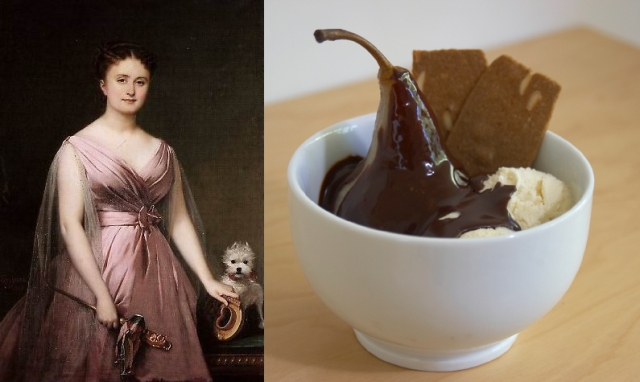


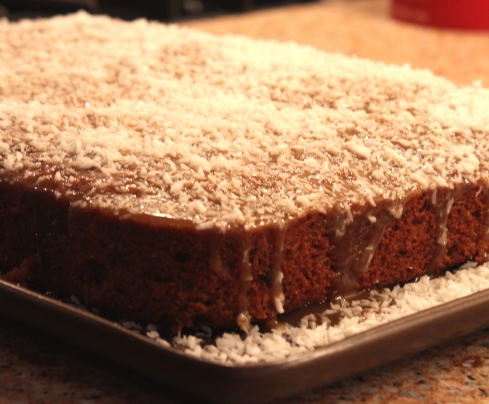

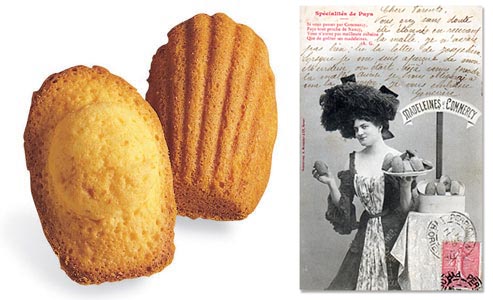


Комментариев нет:
Отправить комментарий